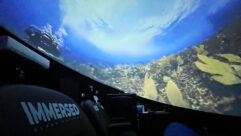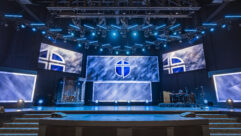Media savvy
Dec 1, 1999 12:00 PM,
Chuck Shriver
We interrupt this program to bring you a news bulletin just in to ourstudios. We do not hear those words often, but when we do, we stop whateverwe are doing and take notice because we know something important hashappened somewhere – down the street, across town, two states away orhalfway around the world – something that may impact our lives. When welisten, we receive news, the end result of a chain of activity that bringsimportant events from anywhere in the world to our attention, sometimes inonly minutes.
Have you ever wondered how that news bulletin got to your television, radioor newspaper? Wonder no more. An unusual museum, the Newseum, brings tolife the business of gathering and disseminating news. Described as “theworld’s only interactive museum of news,” the Newseum provides visitorswith an experience like no other, a trip behind the scenes of television,radio and print journalism.
Located in Arlington, VA, across the Potomac River from Washington, D.C.,the Newseum provides visitors with a sampling of the information that thefree press of a free nation distributes every day, 24 hours a day, and alsogives them, for a few moments, at least, the opportunity to become a TVnews personality or a big-city newspaper editor.
“By taking visitors behind the scenes, we hope to forge a deeperunderstanding of the role of news and a free press in our lives,” said JoeUrschel, executive director and senior vice president of the Newseum, whichis funded and operated by Freedom Forum, a nonpartisan, internationalfoundation dedicated to free press, free speech and free spirit.
To better appreciate the rich, 5,000 year-old history of news, visitors canrelive great news stories of all time through multimedia displays and newsmemorabilia. Included among the Newseum’s artifacts are a pair of PaulRevere’s glasses, one of only nine existing 18th century wooden printingpresses, a camera used by Mathew Brady to photograph the Civil War, famedWorld War II columnist Ernie Pyle’s typewriter, the mic Edward R. Murrowused to broadcast back to America his vivid descriptions of the bombing ofLondon, and a set of color TV studio cameras that brought Walter Cronkite’sevening newscasts into millions of American homes for two decades.
To help visitors grasp the scope of the modern-day process of newsgathering, the $50 million, 72,000 ft superscript 2 (6,700 m superscript 2)facility employs a wide range of technological wizardry. The Newseum uses21 projectors, more than 100 computers, 100 laserdisc players, about 200monitors, 25 Beta tape machines, 63 touchscreen terminals, about 20projection screens (including one that is 126 feet or 38 m long), more than80 miles (129 km) of video, audio, telephone and power cable, and dozens ofloudspeakers.
Two of the Newseum’s more popular features involve immersion technology,where visitors can step in front of TV cameras and mics and be televisionnewscasters or reporters, appear on a magazine cover, investigate a newsstory or, via interactive touchscreen computer programs, edit anews-paper’s front page.
Electrosonic Systems, Burbank, CA, designed the blue screen in theNewseum’s Interactive Newsroom. A visitor, taking on the role of a TVreporter, stands in front of the blank blue screen in the newsroom. Usingchroma key technology, a background image, such as the front steps of theCapitol building, can be inserted onto the blue screen. Then, the reporter,standing in front of the blue screen, reads his or her news report from ateleprompter. Via a computer editing process, the scene is recordeddigitally, inserted between a standard opening and closing, and thereporter is magically transformed into a TV network reporter talking aboutthe latest news from Capitol Hill. For a small charge, the novice reportercan obtain a VHS copy of the TV debut.
Perhaps the most impressive feature of the Newseum is its gigantic, 126foot (38 m) video news wall. The wall is a gallery of the day’s news.Visitors experience the pulse of real breaking news from across the countryand around the world to better understand its enormous scope anduniversality. The 10.5 foot (3.2 m) news wall takes center stage, featuringa panorama of the day’s news gathered via satellite feeds, cable andcomputer networks.
The kaleidoscopic video images and graphics play across a seemingly endlesswall, shifting, overlapping and expanding in an electronic collage ofinformation, imagery and sound. Among the displays are the front pages of70 different newspapers from across the nation and around the world so thateasy comparisons can be made of how news is played, and a news zipper abovethe front pages displays current headlines from the Associated Press asthey are distributed to news outlets around the world.
The video news wall is enormous, composed of nine Stewart Filmscreen screenpanels, displaying images from nine high-resolution Hughes-JVC ILAprojectors mounted on the ceiling in front of the wall. (The configurationof the space precluded rear screen projectors.) The video news wall mixeslive TV news broadcast feeds received via satellite with in-housevideotaped productions. Each of the nine projectors can show a differentimage or can be split into quadrants to produce a total of 36 images.Alternatively, a seamless panoramic image can be displayed across the allthe screens, causing the screens to merge into one huge screen.
“The job required simultaneous hardware and software development,” said JimUpdike, director of engineering for the Newseum, formerly with NBCWorldwide News. “It required an understanding of video, audio and dataprocessing systems integration, and we needed a high-quality video pictureand clear, crisp sound. Electrosonic Systems was chosen because of itsworldwide experience in large-scale video imagery and custom hardware andsoftware systems.”
The challenge was formidable. It required processing many different sourcesin real time, standardizing them to create uniform picture and audioquality and then sizing, positioning, sharing and transitioning the imagesamong nine projectors. The secret to making it all work is Electrosonic’snew system, WORKSURFACE, which took the inventive concepts of Newseumdesigner, Ralph Applebaum Associates of New York and turned them intospectacular reality.
WORKSURFACE is an image processor that accepts and combines scanned displaydata of different resolutions from various sources, including video,graphics, and HDTV. The unit converts the data to digital format and ahardware-based “convolver” resizes each image with each pixel calculatedusing weighed pixel values from the original image. Electrosonic developedthe processor, which it describes as a “pixel picker.” It selects pixelsfrom the input images to make one composite output image. The system canproject any of the images, including full-motion video, in any size withoutlosing picture information or distorting spatial or temporal resolution.
Each of the nine projectors for the video news wall has its ownWORK-SURFACE unit, which supports image resolutions up to1,600infinity1,200. The overall video news wall display is managed by asystem that controls the video sources, processors and programmed audiosystem.
A full-time Newseum production staff creates formal programs and templatesfor the live broadcasts. While the display can run either pre-tapedprograms or live programming, the emphasis is on comparative livebroadcasts. In addition to the images, the WORK-SURFACE system alsocontrols a dynamic audio system. It ensures that the audio heard at any onelocation in the viewing gallery matches the image at that location or inthe case of flying images, the system makes sure the audio flies to matchthe image.
To deliver accurate, time-aligned sound to enhance and enrich theexperience of the video news wall, Electrosonic selected BAG ENDLoudspeaker Systems loudspeakers as the main program loudspeakers. In all,Electrosonic used 15 BAG END TA-12 loudspeaker systems to cover mid- andhigh-frequency audio and 12 BAG END S18-E, single 18 inch (457 mm)subwoofer loudspeaker cabinets driven by nine BAG END ELF-M2 (extended lowfrequency) controllers to handle the job.
BAG END was chosen based on its reputation, according to Electrosonicproject manager Dan Laspa. “We had never used BAG END loudspeakers prior tothis, but the reputation of its ELF (extended low frequency) subwoofersystem was what caught our attention. After testing the loudspeakers, wedecided to use BAG ENDS for the entire system because they were such a goodmatch.”
The BAG END ELF-M2 subwoofer system provides low distortion, extendedlow-frequency response in a compact, highly efficiency design, down to 8Hz. The ELF processor features stereo high-pass output with CVR limitersand dual integrated ELF output with Concealment. ELF cutoff frequency andhigh-pass frequency are internally adjusted with plug-in resistors.
“News today is a video and audio industry,” Updike said. “Our peers takevideo and audio quality very seriously, and their expectations for thismuseum were very high. I’m happy to report the reviews have been glowing.”








